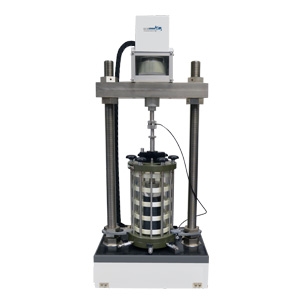
| ELDYN – The GDS Enterprise Level DynamicTriaxial Testing System Is an entry level dynamic triaxial system, based on an axially-stiff load frame with a beam mounted electro-mechanical actuator. The ELDYN has been designed to fulfill the demand within the geotechnical laboratory testing industry for a lower cost, more basic dynamic triaxial testing system, yet still perform to the very advanced standards that customers expect from GDS. The ELDYN allows a cylindrical specimens to be saturated and consolidated to approximate in-situ ground conditions, before monotonic or cyclic loading stages are applied, the latter modelling the stress conditions induced by earthquake shaking. |
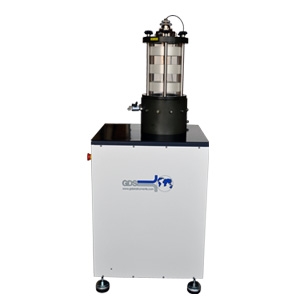
| DYNTTS – Advanced Dynamic Triaxial Testing System
The Advanced Dynamic Triaxial Testing System (DYNTTS) is a high-end testing apparatus that combines a triaxial cell with a dynamic actuator capable of applying cyclic load, deformation and stresses at frequencies up to 10Hz. The cell itself is screw-driven from an integral base unit housing the motor drive. Axial load and deformation are applied through the base of the cell. The system can be combined with a dynamic cell pressure actuator so that cell pressures may also be applied dynamically up to the design frequency of the system. The DYNTTS allows an easy-to-prepare cylindrical specimen to be saturated and consolidated to approximate in-situ ground conditions, before monotonic or cyclic loading stages are applied, the latter modelling the stress conditions induced by earthquake shaking. Note user-defined cyclic loading patterns can also be applied to the test specimen when using the DYNTTS.
|
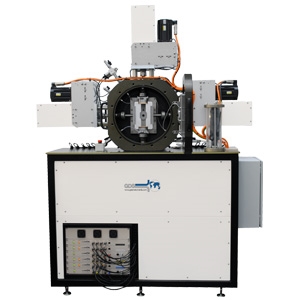
| GDSTTA– The GDS True Triaxial Apparatus
Has the defining characteristic that, unlike conventional triaxial apparatus, all three principal stresses can be controlled independently, rather than just two in a conventional triaxial system. This allows a wider range of complex stress paths to be performed. This dynamic cyclic system is powered by advanced electro-mechanical actuators or optional hydraulic actuators and is an extremely sophisticated research tool. Vertical and one horizontal axis are loaded via the dynamic actuators (axis 1 and 2), stress control is provided for the 2nd horizontal axis, (axis 3) via cell pressure. Altogether the GDSTTA can be used to apply a wide range of stress paths to soil specimens, both statically and dynamically, enabling assessment of soil response under earthquake loadings.
|
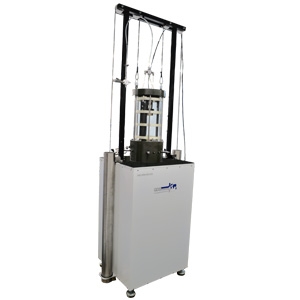
| HCA – Hollow Cylinder Apparatus
The Hollow Cylinder Apparatus (HCA) allows rotational displacement and torque to be applied cyclically to a hollow cylindrical specimen of soil, in addition to axial load and deformation, at frequencies up to 5 Hz. Using this device it is possible to control the magnitude and direction of the three principal stresses, providing the most complete apparatus for loading a soil specimen along any stress path. The system may also be combined with two dynamic cell pressure actuators to enable outer and inner cell pressures to be applied dynamically. Preparation of cohesive and granular specimens is possible using the supplied preparation kit. Note user-defined cyclic loading patterns can also be applied to the test specimen when using the HCA. |
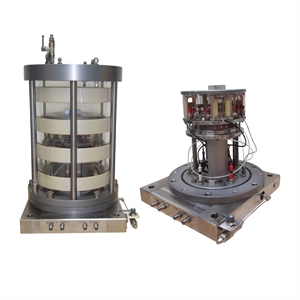
| RCA – Resonant Column Apparatus
The Resonant Column Apparatus (RCA) is used to obtain values of the shear modulus, Young’s modulus, and damping coefficient across the small to medium shear strain range (<1 %). This is achieved through use of an electro-magnetic drive system, which applies high frequency (15 – 300 Hz) torsional or flexural cyclic loading to saturated and consolidated cylindrical soil specimens. Note the system can also be upgraded to carry out torsional shear tests in the 2 Hz and below frequency range, allowing the full shear stress-strain behaviour to be observed. Parameters gained from a resonant column apparatus allow dynamic response analyses to be conducted, such as those using finite element and non-linear analytical methods, enabling the response of soil deposits during earthquake shaking to be assessed. |
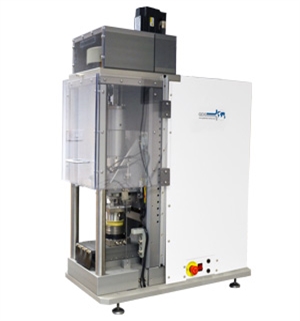
| EMDCSS – Electromechanical Dynamic Cyclic Simple Shear
The Electromechanical Dynamic Cyclic Simple Shear device (EMDCSS) is used for the simple shear testing of cylindrical soil specimens. It is capable of carrying out dynamic cyclic tests from small strain (0.005 % shear strain amplitude) to large strain (10 % shear strain amplitude), as well as extremely accurate quasi-static loading. The easy-to-prepare specimen is subjected to principal stress rotation representative of many soil responses observed in the field. Note user-defined cyclic loading patterns, such as acceleration time histories recorded during earthquake shaking, can also be applied to the test specimen when using the EMDCSS.
|
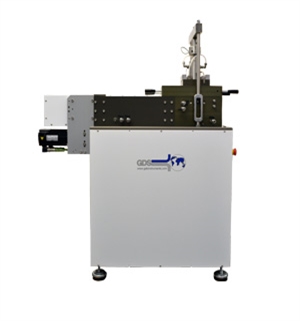
| DYNBPS – The Dynamic Back Pressured Shearbox
Is used for static and dynamic direct shear testing on soil specimens with control of pore pressures. The control of pore pressure during direct shear testing allows real-world situations to be modelled in the laboratory. This dynamic version of the device allows a landslide to be modelled as it quickly gains velocity after the initial moment of failure, or to observe failure occur under cyclic stresses induced by an earthquake. Note cyclic direct shear testing is possible while still controlling and measuring pore pressure. |
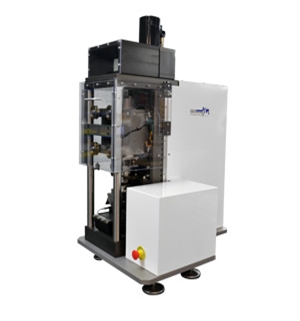
| VDDCSS – Variable Direction Cyclic Simple Shear
The Variable Direction Cyclic Simple Shear device (VDDCSS) enables simple shear to be applied in two directions, rather than the standard single direction. This is achieved through use of a secondary shear actuator that acts at 90 degrees to the primary shear actuator. When used as a variable direction system, the secondary shear axis load and displacement can be applied independently of the primary shear axis. This allows simple shear tests to be performed in any horizontal direction, approximating complex loading patterns observed in the field from events such as earthquakes. |
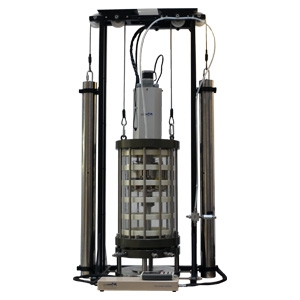
| HARRCA– Hardin Type Resonant Column Apparatus
Is a system that allows specimens to be tested in resonance while maintaining an anisotropic loading. This is achieved by a slender, thin walled loading column passing through the drive system to the top-cap. The GDS Hardin style oscillator contains an electro-magnetic drive system incorporating precision wound coils and composite sintered neodymium iron boron (NdFeB) “rare-earth” magnets. The apparatus can be mounted in a stand-alone system with an integral axial force actuator, or as a cell for integration into an existing load frame. Providing G and D curves for soil specimens, the HARRCA enables dynamic analyses to be performed when assessing soil deposit response during earthquake loadings.
|
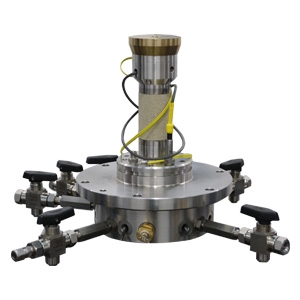
| GDSAV - Acoustic Velocity transducer
The Acoustic Velocity transducers allow P- and S-wave velocities to be measured within a rock specimen. The transducer are mounted in the pedestal and top-cap, or in some cases the sides of the specimen. |
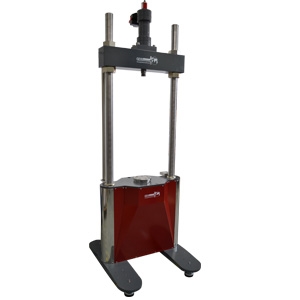
| DT-RTS Dynamic Triaxial Rock Testing System
The Dynamic Triaxial Rock Testing System can apply axial loads of up to 1.5MN at dynamic frequencies of 20Hz and below. Dynamic loading is achieved using a servo-hydraulic actuator system. |